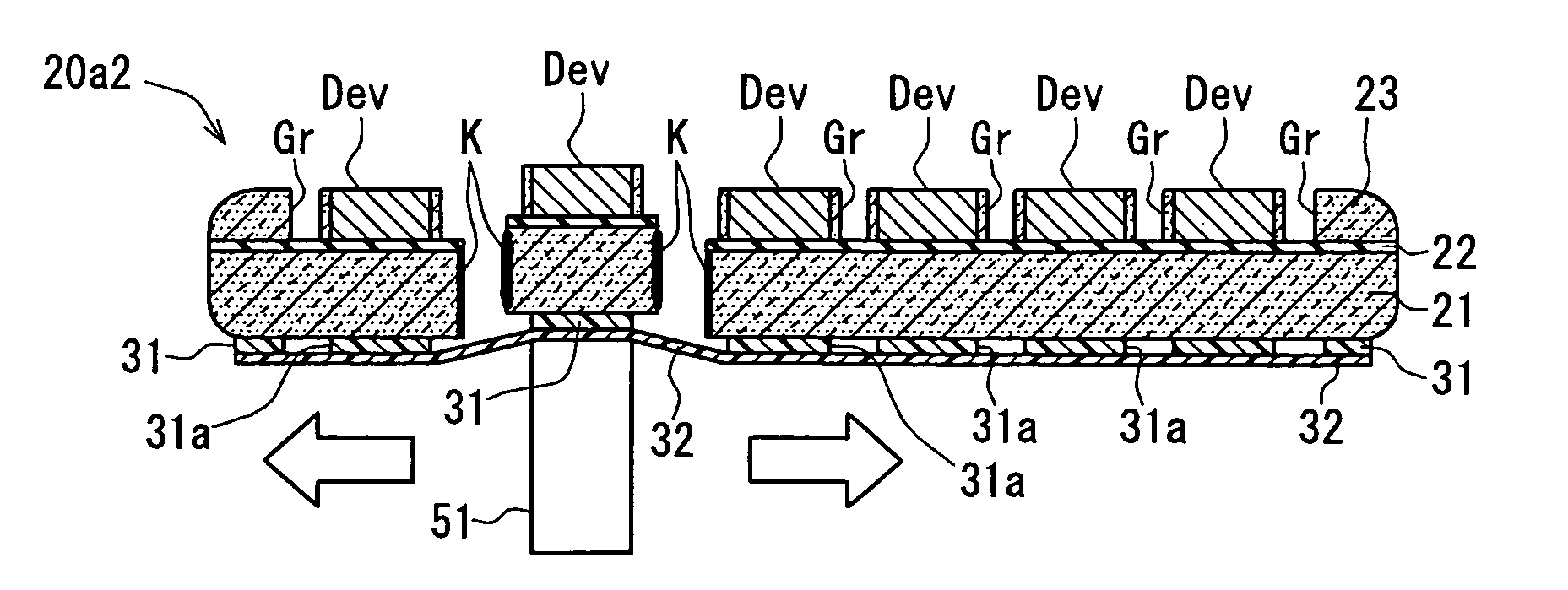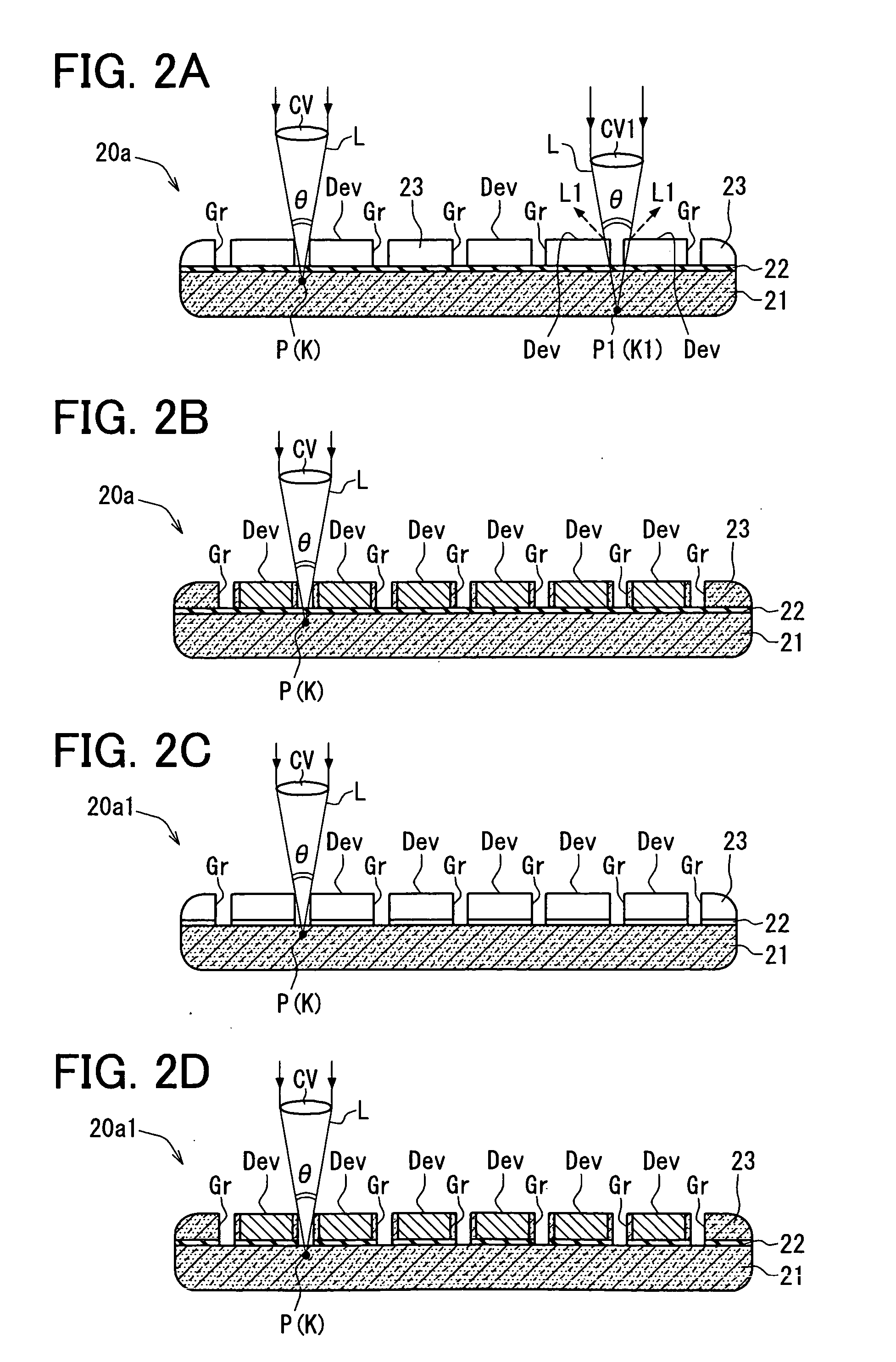Semiconductor wafer having multiple semiconductor elements and method for dicing the same
a technology of semiconductor elements and semiconductor wafers, applied in the field of semiconductor wafers, can solve the problems of increasing the manufacturing cost of each chip, difficult to form the modified region on the multi-layer wafer, and difficult to form the modified region uniformly, so as to achieve high yield ratio and high quality
- Summary
- Abstract
- Description
- Claims
- Application Information
AI Technical Summary
Benefits of technology
Problems solved by technology
Method used
Image
Examples
first embodiment
[0027] A semiconductor wafer 20a according to a first embodiment of the present invention is shown in FIG. 1. The wafer 20a is a silicon substrate 21 having a thin disk shape and made of silicon. The wafer 20a includes an orientation flat 40 for representing a crystal orientation. The orientation flat 40 of the wafer 20a is disposed on a part of an outer periphery of the wafer 20a. As shown in FIGS. 2A and 2B, the wafer 20a includes a silicon substrate 21, an embedded oxide layer 22 and a SOI layer 23, which are stacked in this order. Thus, the wafer 20a is a SOI wafer having multi-layer structure.
[0028] On the surface of the wafer 20a, multiple chips Dev are arranged to be a grid. Each chip Dev is formed on the wafer 20a in a semiconductor process such as a diffusion step. The wafer 20a is separated into the chips Dev by using a laser beam. The laser beam is scanned along with a cutting line DL, i.e., a dicing line.
[0029] A layer removal region as a groove Gr is formed on the waf...
second embodiment
[0041] A semiconductor wafer 20b according to a second embodiment of the present invention is shown in FIGS. 4, 5A and 5B. In the wafer 20b, the layer removal region, i.e., the groove Gr, is formed around the chip Dev. Therefore, the groove Gr does not reach the outer periphery of the wafer 20b. The groove Gr in the wafer 20b is not formed in an outer periphery region R, so that the groove does not disposed from one outer periphery end of the wafer 20b to the other outer periphery end.
[0042] As shown in FIG. 4, the groove Gr along with the cutting line DL is formed in such a manner that the groove Gr surrounds multiple chips Dev in the wafer 20b. Specifically, the groove Gr surrounds a chip to be formed region. Thus, the groove Gr in the wafer 20b is formed to minimize an area of the groove Gr on the cutting line DL of the laser beam L. The groove Gr is formed in a necessity minimum area for separating all chips Dev. In the groove Gr, only part of the SOI layer 23 is removed from t...
third embodiment
[0045] A semiconductor wafer 20c according to a third embodiment of the present invention is shown in FIGS. 6, 7A and 7B. In the wafer 20c, an outer layer removal region Gr1 disposed in the outer periphery region R is formed. Specifically, the outer layer removal region Gr1 is disposed on an outside from the utmost outer chip Dev1. Here, the outer periphery region R is disposed outside of the utmost outer chip Dev1, which is disposed on the utmost outside of the wafer 20c. The outer layer removal region Gr1 is formed on a wide area including the cutting line DL. Thus, not only the groove Gr as the layer removal region but also the outer layer removal region Gr1 are formed in the wafer 20c so that the groove Gr and the outer layer removal region Gr1 are disposed on the wafer 20c other than the chips Dev and its surrounding area. Here, in the wafer 20c, only a part of the SOI layer 23 is removed from the wafer 20c, and the oxide layer 22 and the silicon substrate 21 are not removed fr...
PUM
 Login to View More
Login to View More Abstract
Description
Claims
Application Information
 Login to View More
Login to View More - R&D
- Intellectual Property
- Life Sciences
- Materials
- Tech Scout
- Unparalleled Data Quality
- Higher Quality Content
- 60% Fewer Hallucinations
Browse by: Latest US Patents, China's latest patents, Technical Efficacy Thesaurus, Application Domain, Technology Topic, Popular Technical Reports.
© 2025 PatSnap. All rights reserved.Legal|Privacy policy|Modern Slavery Act Transparency Statement|Sitemap|About US| Contact US: help@patsnap.com



